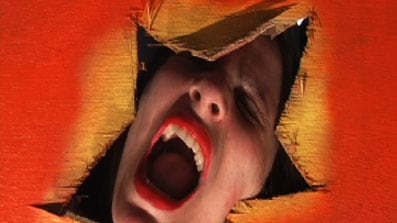Knock Knock: Who’s There? That Joke Isn’t Funny Anymore examines the delicate relationship between art and humor, and—it must be said straightaway—you won’t find it a laugh a minute. But that’s not the point. Sarah Murkett and Elana Rubinfeld who co-curated the show in two New York venues— Armand Bartos Fine Art and Fred Torres Collaborations—make it plain that the intention is to explore the various ways artists have used humor to address more serious issues.
As such, the choices in the show are provocative but occasionally bear out the old adage: Dying is easy, comedy is hard. Many of the pieces are witty or droll—but they would be even funnier as stand-alones if they didn’t have to compete with so many different comic voices.
Click Image to View Our Gallery of Humorous Art

I liked Justin Cooper’s photographs of swaddled heads, the Failure Drawing by the always interesting William Pope L. and David La Chapelle’s subversive photographs—particularly one in which an un-punkish teen is giving a puppy a drink from a can of Bud—and also the cheerful vulgarity of Larry Miller’s Orifice Flux Plugs and Robert Watt’s Booger Sizing Chart.
But, as is inevitable at a crowded comedy show, I sometimes simply don’t get the joke. Philip Guston’s use of comic strip pictorial language has always seemed to me his way of establishing grim prole authenticity (like his cigar butts and hooded Klansmen), rather than as an appeal to the Comic Muse. And Star Bright, Star Might, the Kate Gilmore video at Torres, in which the artist is trying to deal with an obstacle, stuck me as simply poignant.
Delphine Reist’s piece at Fred Torres—four metal stands blow party noise-makers every now and again—actually induces a laugh. And the stand-out pieces of the whole show are Shannon Plumb’s videos at Armand Bartos, which are not only hilarious but made me wonder why more video artists don’t exploit the comedy potential of the medium. (Bruce Nauman’s Clown videos are terrific but funny? Nah!) Until I realized I knew the answer. A ho-ho joke can disrupt, as much as, say, images of explicit sex. Which, I suppose, is why artists tend to approach laugh-out-loud humor in such a gingerly fashion—American artists in particular.
Marcel Duchamp was up for it, of course. There are several Duchamps at Bartos and while his most overtly funny pieces could be painfully punnish—L.H.O.O.Q.? Please!—he also used plenty of humor in his readymades. “Humor was a sort of savior so to speak, Duchamp said in a 1960 interview. “Because, before, art was such a serious thing, so pontifical that I was very happy when I discovered I could introduce humor into it. And that was truly a period of discovery.” Duchamp also credited Jean Arp with advancing the use of the joke. He wrote: “The important element introduced by Arp was ‘humor’ in its subtlest form, the kind of whimsical conceptions that gave to the Dada Movement an exuberant liveliness as opposed to the purely intellectual tendencies of Cubism and Expressionism. Arp showed the importance of a smile to combat the sophistic theories of the moment.”
But artists in the United States have usually been cagey about humor. The New Yorker’s late, great Saul Steinberg, would, I think, be generally described as a superlative cartoonist but Arne Glimcher of PaceWildenstein, Steinberg’s dealer, observes that he always refused to be so characterized. “He saw himself in terms of Picabia or Klee,” Glimcher says. “Early Picabia. He always rejected the idea that he was a cartoonist.”
Similarly, I once actually laughed in front of a Neil Jenney canvas at a 2001 show at Gagosian—a real laugh, not the knowing chuckle you get from people telegraphing that they’ve got the point of some four hundred year old witticism in Shakespeare. But when I recently mentioned this to Jenney he said “I’ve always had a lighthearted attitude somehow. But I don’t really intend my stuff to be humorous. It’s supposed to transcend humor somehow.” He added “When you make art you really kind of wish that it would be as profound as possible. And the humorous part tends to be a little on the superficial side to some degree.”
That’s American artists. Euros clearly feel very differently. Consider Francesco Vezzoli. Or Maurizio Cattelan, many of whose pieces can resemble cartoons in existential quest of a caption. Or the sometimes savagely funny Chapmans. Or Glasgow’s David Shrigley. Indeed as John Wesley, another potently amusing American painter, observed to me, “the worst thing you can say about a Briton is that they don’t have a sense of humor.”
Visit Knock Knock—it’ll take you places the art world doesn’t often go.
Plus: Check out Art Beast for galleries, interviews with artists, and photos from the hottest parties.
Anthony Haden-Guest is the news editor of Charles Saatchi’s online magazine.





